![]()
![]()
![]()
Use LEFT and RIGHT arrow keys to navigate between flashcards;
Use UP and DOWN arrow keys to flip the card;
H to show hint;
A reads text to speech;
31 Cards in this Set
- Front
- Back
|
Physics with mechanics:
|
the study of the relationships among force, matter, and motion
|
|
|
kinematics:
|
the part of mechanics that enables us to describe motion
|
|
|
dynamics:
|
relates motion to its causes
|
|
|
Displacement:
|
a vector points along from P1 to P2
|
|
|
the x-component of the displacement:
|
the change in the value of x, that took place during the time interval.
|
|
|
average velocity:
|
a vector quantity whose x-component is the change in x divided by the time interval
ex: m/s - depends on the particular time interval chosen. |
|
|
average x-velocity:
|

the x-component of displacement, divided by the time interval during which the displacement occurs
|
|
|
2.1 positions of a dragster at two times during its run.
|

|
|
|
simple rules for the average x-velocity:
|
- whenever x is positive & increasing or is negative and becoming less negative, the particle is moving in the + x-direction and avg. velocity is positive.
- whenever x is positive and decreasing or is negative and becoming more negative, the particle is moving in the - x-direction and avg. velocity is negative. (if a particle moves in the negative x-direction during a time interval, its avg. velocity for that time interval is neg. ) |
|
|
2.3 The position of a dragster as a function of time:
|
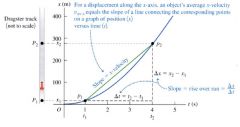
|
|
|
Instantaneous velocity:
|
tells us how fast / in what direction the particle was moving at any given time during the interval.
velocity at any specific instant of time or specific point along the path. |
|
|
The instantaneous velocity:
|

- the limit of the average velocity as the time interval approaches 0.
- the instantaneous rate of change of position with time. Vx = instantaneous velocity + value: x is increasing and the motion is in the positive x-direction - value: x is decreasing and the motion is in the negative x-direction. |
|
|
Speed:
|
the distance traveled divided by time.
V = instantaneous speed it measures how fast and in what direction object is moving. |
|
|
Scalar:
|
a simple physical quantity that is not changed by coordinate system rotations or translations...
no info. about direction. |
|
|
Motion diagram:
|
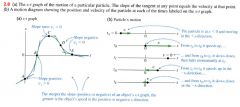
shows the particle's position at various times as well as arrows to represent the particles velocity at each instant.
|
|
|
Average acceleration:
|

as it moves from P1 to P2 to be a vector quantity whose x-component
a av-x (average x-acceleration) equals the change in the x-component velocity divided by the time interval of the change in time. |
|
|
Velocity:
|
describes how a body's position changes with time.
- tells us how fast and in what direction the body moves = dx/dt (the derivative of the position with respect to time) |
|
|
acceleration:
|
describes how the velocity changes with time.
- it tells us how the speed and direction of motion are changing. = dv/dt (the derivative of velocity with respect to time) |
|
|
The instantaneous acceleration:
|

the limit of the average acceleration as the time interval approaches 0.
- equals the instantaneous rate of change of velocity with time. |
|
|
2.12: a graph of motion:
|
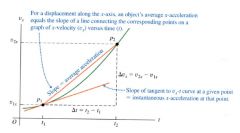
|
|
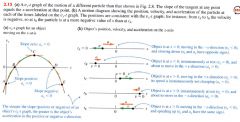
|

|
|
|
Velocity of x at constant acceleration:
|

|
|
|
Final position formula using its initial position, initial velocity, acceleration (at constant x-acceleration)
|

|
|
|
Equations of motion with constant acceleration:
|

|
|
|
Problem-solving strategy 2.1: Motion with Constant Acceleration:
|
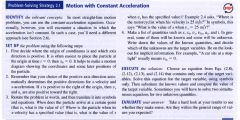
|
|
|
Free Fall:
|
the motion of a falling object that is influenced by and only by gravity:
- includes rising as well as falling motion. |
|
|
Acceleration due to gravity:
|
the constant acceleration of a freely falling body:
- denote its magnitude with (g) g = 9.8m/ sq. sec. g= 980cm/sq.sec. g= 32ft/sq. sec. note: since g is the magnitude of a vector quantity, it is always a positive number |
|
|
How can we find the position and velocity from the acceleration function Ax(t)?
|

|
|
|
Velocity with varying acceleration:
|

|
|
|
Position with varying acceleration:
|

|
|
|
Chapter 2 summary:
|
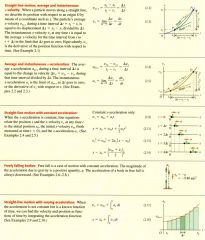
|

